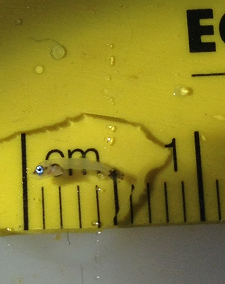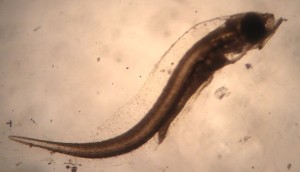As a follow up to my spawn party article, I wanted to update y’all on the larvae I am currently drowning in. I plan to share some awesome videos and pictures with you.The last time I talked about the spawn party, I mentioned that I collected some 14,000 eggs. If you want to see what they looked like after I collected them, see the spawn party post here. Now at 29 days post hatch (DPH) they are still going strong. Here is the most recent picture I have of them at 18DPH.
Along with rearing different larvae, I’m currently running an experiment on the reef tank to see if spawn density is effected by the moon cycle. To do this I am collecting eggs from the tank every night. A few weeks ago, I took the plankton tow off in the morning and found to my surprise loads of larvae.
The photo to the left of this paragraph is very interesting. It’s a picture ofone of the larvae under a microscope. If you pay special attention to the color of its eyes, you’ll notice that it has common traits familiar with damselfish larvae. Seeing as Joe has many different species of damselfish in his reef tank I can’t say for sure which species it is. However, due to the size and development the larvae had when I collected them, it can be determined that they are from a demersal spawning species.
I took this larvae-palooza and split it between 3 different rearing vats. So far, I have had fair luck and the larvae are still alive in all 3 vats. Since I don’t know which species they are, I can only assume that they shall be settling out in the next 5-10 days.
At 7DPH, I noticed a smaller larva swimming around in the vats with the damselfish larvae. This other pelagic larva was about the same size the damselfish larvae were when I first collected them. They don’t have any stand-out features as of now so there is no way to determine their species as of yet. Although, I enjoy the surprise as well as the fact that I get to work with such a variety of larvae.
Hopefully soon, I will be able to identify all the types of larvae I currently am working on. Please stay tuned to find out what species they are!














Do you breed all these larvae in the same tank/enclosure?